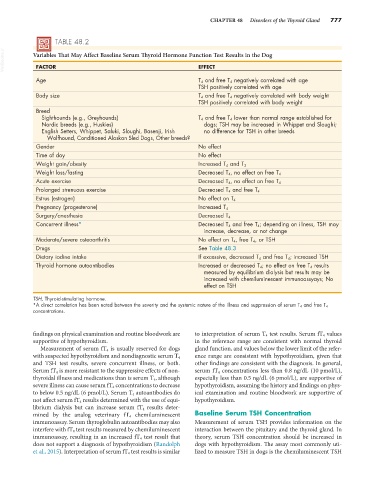Page 805 - Small Animal Internal Medicine, 6th Edition
P. 805
CHAPTER 48 Disorders of the Thyroid Gland 777
TABLE 48.2
VetBooks.ir Variables That May Affect Baseline Serum Thyroid Hormone Function Test Results in the Dog
FACTOR
EFFECT
Age T 4 and free T 4 negatively correlated with age
TSH positively correlated with age
Body size T 4 and free T 4 negatively correlated with body weight
TSH positively correlated with body weight
Breed
Sighthounds (e.g., Greyhounds) T 4 and free T 4 lower than normal range established for
Nordic breeds (e.g., Huskies) dogs; TSH may be increased in Whippet and Sloughi;
English Setters, Whippet, Saluki, Sloughi, Basenji, Irish no difference for TSH in other breeds
Wolfhound, Conditioned Alaskan Sled Dogs, Other breeds?
Gender No effect
Time of day No effect
Weight gain/obesity Increased T 4 and T 3
Weight loss/fasting Decreased T 4 , no effect on free T 4
Acute exercise Decreased T 4, no effect on free T 4
Prolonged strenuous exercise Decreased T 4 and free T 4
Estrus (estrogen) No effect on T 4
Pregnancy (progesterone) Increased T 4
Surgery/anesthesia Decreased T 4
Concurrent illness* Decreased T 4 and free T 4 ; depending on illness, TSH may
increase, decrease, or not change
Moderate/severe osteoarthritis No effect on T 4 , free T 4 , or TSH
Drugs See Table 48.3
Dietary iodine intake If excessive, decreased T 4 and free T 4; increased TSH
Thyroid hormone autoantibodies Increased or decreased T 4 ; no effect on free T 4 results
measured by equilibrium dialysis but results may be
increased with chemiluminescent immunoassyays; No
effect on TSH
TSH, Thyroid-stimulating hormone.
*A direct correlation has been noted between the severity and the systemic nature of the illness and suppression of serum T 4 and free T 4
concentrations.
findings on physical examination and routine bloodwork are to interpretation of serum T 4 test results. Serum fT 4 values
supportive of hypothyroidism. in the reference range are consistent with normal thyroid
Measurement of serum fT 4 is usually reserved for dogs gland function, and values below the lower limit of the refer-
with suspected hypothyroidism and nondiagnostic serum T 4 ence range are consistent with hypothyroidism, given that
and TSH test results, severe concurrent illness, or both. other findings are consistent with the diagnosis. In general,
Serum fT 4 is more resistant to the suppressive effects of non- serum fT 4 concentrations less than 0.8 ng/dL (10 pmol/L),
thyroidal illness and medications than is serum T 4 , although especially less than 0.5 ng/dL (6 pmol/L), are supportive of
severe illness can cause serum fT 4 concentrations to decrease hypothyroidism, assuming the history and findings on phys-
to below 0.5 ng/dL (6 pmol/L). Serum T 4 autoantibodies do ical examination and routine bloodwork are supportive of
not affect serum fT 4 results determined with the use of equi- hypothyroidism.
librium dialysis but can increase serum fT 4 results deter-
mined by the analog veterinary fT 4 chemiluminescent Baseline Serum TSH Concentration
immunoassay. Serum thyroglobulin autoantibodies may also Measurement of serum TSH provides information on the
interfere with fT 4 test results measured by chemiluminescent interaction between the pituitary and the thyroid gland. In
immunoassay, resulting in an increased fT 4 test result that theory, serum TSH concentration should be increased in
does not support a diagnosis of hypothyroidism (Randolph dogs with hypothyroidism. The assay most commonly uti-
et al., 2015). Interpretation of serum fT 4 test results is similar lized to measure TSH in dogs is the chemiluminescent TSH

